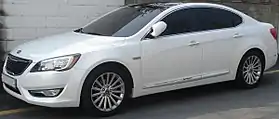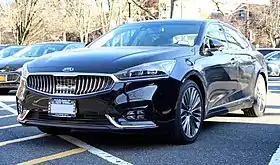Kia Cadenza
The Kia Cadenza (also known in South Korea as Kia K7) is a full-size/executive sedan manufactured by Kia Motors. It was launched in 2010 to replace the Kia Opirus/Amanti.[1]
| Kia Cadenza | |
|---|---|
.jpg.webp) | |
| Overview | |
| Manufacturer | Kia Motors |
| Also called | Kia K7 (South Korea) |
| Production | 2009–present |
| Body and chassis | |
| Class | Full-size car/Executive car |
| Body style | 4-door sedan |
| Layout | Front-engine, front-wheel-drive |
| Related | Hyundai Grandeur Hyundai Aslan |
| Chronology | |
| Predecessor | Kia Amanti/Opirus |
As of January 2014, it was sold in South Korea, United States, Canada, China, Colombia, Brazil, Chile, and the Middle East.
First generation (VG; 2009–2016)
| Kia Cadenza (VG) | |
|---|---|
 | |
| Overview | |
| Manufacturer | Kia Motors |
| Also called | Kia K7 (South Korea) |
| Production | 2009–2016 |
| Model years | 2010–2016 |
| Assembly | Hwasung, South Korea (Kia) Oskemen, Kazakhstan (Azia Avto) |
| Designer | Peter Schreyer |
| Body and chassis | |
| Class | Large / Executive car |
| Body style | 4-door sedan |
| Layout | Front-engine, front-wheel-drive |
| Platform | Type-N |
| Powertrain | |
| Engine | |
| Transmission | 6-speed automatic |
| Dimensions | |
| Wheelbase | 2,845 mm (112.0 in) |
| Length | 4,965 mm (195.5 in) |
| Width | 1,850 mm (72.8 in) |
| Height | 1,475 mm (58.1 in) |
| Curb weight | 1,505–1,690 kg (3,318–3,726 lb) |
The Cadenza uses the new front-wheel-drive Type-N platform[2] with MacPherson front suspension and a multilink rear suspension. Cadenza will be offered with three gasoline engines ranging from 165 horsepower to 290 horsepower for the 3.5-liter Lambda, included the new 2.4-liter Theta II with gasoline direct injection (GDI) and 201 horsepower. A hybrid K7 700h is available in Korea, with a 159 hp four cylinder and a 35 kW electric motor.[3]
The Kia Cadenza was designed by Kia design chief Peter Schreyer who was chief designer at Audi and uses Kia's corporate Tiger Nose grille.
In January 2013, Kia announced that the Cadenza will be available in the United States. It is Kia's version of the Hyundai Azera. Standard features will include leather seats, Bluetooth, a navigation system, Kia UVO, alloy wheels, and other luxury car features. This will be one of four Korean luxury sedans sold in the United States, the other three cars being the Hyundai Genesis, Kia K900 and Hyundai Equus, which are currently on sale in the United States, and are manufactured by Hyundai and Kia.
The car features Nappa leather seats, a feature commonly found on more expensive vehicles such as those from BMW and Mercedes-Benz. The Nappa leather is available in three colors: black, beige, or white (the white interior requires all three packages available on the Cadenza: the Luxury, Technology, and White Interior Packages). The driver's seat is both heated and ventilated, and the passenger's seat is heated. The rear seats can also be heated. A dual sunroof is available. The car features the 3.3L, 294 horsepower V6, the most powerful engine available for the Cadenza. The engine is used in the Cadenza's platform mate, the Hyundai Azera, and is a Hyundai-built engine from the Lambda engine family.
Powertrain
| Model | Year | Transmission | Power | Torque |
|---|---|---|---|---|
| Petrol | ||||
| Theta II 2.4 MPI | 2009–2011 | 6-speed automatic | 180 PS (132 kW; 178 hp) @ 6000 rpm | 23.5 kg⋅m (230 N⋅m; 170 lbf⋅ft) @ 4000 rpm |
| Theta II 2.4 MPI Hybrid | 2013–2016 | 200 PS (147 kW; 197 hp) @ 5500 rpm | ||
| Theta II 2.4 GDI | 2011–2016 | 201 PS (148 kW; 198 hp) @ 6300 rpm | 25.5 kg⋅m (250 N⋅m; 184 lbf⋅ft) @ 4250 rpm | |
| Mu 2.7 MPI | 2009–2011 | 200 PS (147 kW; 197 hp) @ 6000 rpm | 26 kg⋅m (255 N⋅m; 188 lbf⋅ft) @ 4500 rpm | |
| Lambda II 3.0 GDI | 2011–2016 | 270 PS (199 kW; 266 hp) @ 6400 rpm | 31.6 kg⋅m (310 N⋅m; 229 lbf⋅ft) @ 5300 rpm | |
| Lambda II 3.3 GDI | 294 PS (216 kW; 290 hp) @ 6400 rpm | 35.3 kg⋅m (346 N⋅m; 255 lbf⋅ft) @ 5200 rpm | ||
| Lambda II 3.5 MPI | 2009–2016 | 290 PS (213 kW; 286 hp) @ 6600 rpm | 34.5 kg⋅m (338 N⋅m; 250 lbf⋅ft) @ 5000 rpm | |
| LPG | ||||
| Mu 2.7 LPI | 2009–2011 | 6-speed automatic | 165 PS (121 kW; 163 hp) @ 5200 rpm | 25 kg⋅m (245 N⋅m; 181 lbf⋅ft) @ 4000 rpm |
| Lambda II 3.0 LPI | 2011–2016 | 235 PS (173 kW; 232 hp) @ 6000 rpm | 28.6 kg⋅m (280 N⋅m; 207 lbf⋅ft) @ 4500 rpm | |
Gallery
 Kia Cadenza in China
Kia Cadenza in China Kia Cadenza F/L
Kia Cadenza F/L Kia Cadenza F/L
Kia Cadenza F/L
Second generation (YG; 2016–present)
| Kia Cadenza (YG) | |
|---|---|
 | |
| Overview | |
| Manufacturer | Kia Motors |
| Also called | Kia K7 (South Korea) |
| Production | 2016–present |
| Model years | 2017–present |
| Assembly | Hwasung, South Korea (Kia) |
| Designer | Peter Schreyer |
| Body and chassis | |
| Class | Large / Executive car |
| Body style | 4-door sedan |
| Layout | Front-engine, front-wheel-drive |
| Platform | Type-N |
| Powertrain | |
| Engine | |
| Electric motor | 38kW permanent magnet high-power density motor |
| Transmission | 6-speed automatic 8-speed automatic |
| Battery | 1.76 kWh Li-ion Polymer |
| Dimensions | |
| Wheelbase | 2,855 mm (112.4 in) |
| Length | 4,970 mm (195.7 in) (2016–2019) 4,995 mm (196.7 in) (2020–present) |
| Width | 1,870 mm (73.6 in) |
| Height | 1,470 mm (57.9 in) |
| Curb weight | 1,555–1,730 kg (3,428–3,814 lb) |
Released in Fall 2016, the second generation Kia Cadenza was redesigned by Peter Schreyer. The car is offered with a revised 3.3 liter V6 that generates 290 horsepower (294 PS; 216 kW). Aside from the 6-speed automatic, the Cadenza is offered with a new in-house developed 8-speed automatic with a drive mode select system.[4]
2019 update
The Cadenza received a facelift in June 2019. Mechanical changes include a new 2.5L SmartStream G engine replacing the 2.4L Theta II GDI engine while the 3.5L Lambda II MPI engine replaces the 3.3L Lambda II GDI engine in a some regions. For styling, the update includes a new grille and hood, new front and rear bumpers, new wheel design and a new 12.3 inch infotainment touchscreen.
The Cadenza was discontinued in Canada after the 2019 model year, and in the US after the 2020 model year.[5] Kia cited the market transition from large cars to crossovers and SUVs.
Powertrain
| Model | Year | Transmission | Power | Torque |
|---|---|---|---|---|
| Petrol | ||||
| Theta II 2.4 GDI | 2016–2019 | 6-speed automatic | 190 PS (140 kW; 187 hp) @ 6000 rpm | 24.6 kg⋅m (241 N⋅m; 178 lbf⋅ft) @ 4000 rpm |
| Smartstream G2.5 GDI | 2019–present | 8-speed automatic | 198 PS (146 kW; 195 hp) @ 6100 rpm | 25.3 kg⋅m (248 N⋅m; 183 lbf⋅ft) @ 4000 rpm |
| Lambda II 3.0 GDI | 2018–present | 266 PS (196 kW; 262 hp) @ 6400 rpm | 31.4 kg⋅m (308 N⋅m; 227 lbf⋅ft) @ 5300 rpm | |
| Lambda II 3.3 MPI | 2016–2019 | 6-speed automatic | 270 PS (199 kW; 266 hp) @ 6400 rpm | 32.4 kg⋅m (318 N⋅m; 234 lbf⋅ft) @ 4500 rpm |
| Lambda II 3.3 GDI | 2016–present | 8-speed automatic | 284 PS (209 kW; 280 hp) @ 6400 rpm 294 PS (216 kW; 290 hp) @ 6400 rpm |
34.3 kg⋅m (336 N⋅m; 248 lbf⋅ft) @ 5200 rpm 35 kg⋅m (343 N⋅m; 253 lbf⋅ft) @ 5200 rpm |
| Lambda II 3.5 MPI | 2020–present | 290 PS (213 kW; 286 hp) @ 6600 rpm | 34.5 kg⋅m (338 N⋅m; 250 lbf⋅ft) @ 5000 rpm | |
| Hybrid | ||||
| Theta II 2.4 MPI Hybrid | 2016–present | 6-speed automatic | 200 PS (147 kW; 197 hp) @ 5500 rpm | |
| LPG | ||||
| Lambda II 3.0 LPI | 2016–present | 6-speed automatic | 235 PS (173 kW; 232 hp) @ 6000 rpm | 28.6 kg⋅m (280 N⋅m; 207 lbf⋅ft) @ 4500 rpm |
| Diesel | ||||
| R II 2.2 CRDI | 2016–2020 | 8-speed automatic | 202 PS (149 kW; 199 hp) @ 3800 rpm | 45 kg⋅m (441 N⋅m; 325 lbf⋅ft) @ 1750–2750 rpm |
Safety
The Cadenza received a "Top Safety Pick+" rating from the Insurance Institute for Highway Safety (IIHS).[6]
| Test | Rating |
| Overall: | |
| Small overlap front: | Good |
| Moderate overlap front: | Good |
| Side: | Good |
| Roof strength: | Good |
| Head restraints & seats: | Good |
| Front crash prevention: | Superior |
| Headlights: | Acceptable |
| Child seat anchors (Latch) ease of use: | Marginal |
Gallery
.jpg.webp) Rear view
Rear view K7 facelift front
K7 facelift front K7 facelift rear
K7 facelift rear
Sales
| Calendar year | South Korea[7] | United States[8] |
|---|---|---|
| 2010 | 42,544 | N/A |
| 2011 | 23,708 | |
| 2012 | 20,169 | |
| 2013 | 25,330 | 8,626 |
| 2014 | 22,453 | 9,267 |
| 2015 | 20,805 | 7,343 |
| 2016 | 56,060 | 4,738 |
| 2017 | 46,578 | 7,249 |
| 2018 | 40,978 | 4,507 |
| 2019 | 55,839 | 1,630 |
| 2020 | 41,048 | 1,265 |
References
- "2011 Kia Cadenza - Official Photos & Info - Auto Reviews - Car & Driver". Caranddriver.com. Retrieved 9 October 2010.
- "Specification". Carscoop.blogspot.com. 24 November 2009. Retrieved 9 October 2010.
- "기아 올 뉴 K7 하이브리드 특징 - 연비좋은 하이브리드 자동차 | 기아자동차 공식 사이트". Kia.com. Retrieved 20 February 2017.
- Bassett, Abigail (18 August 2016). "2017 Kia Cadenza First Drive Review: Splitting the Hairs of Luxury". Motor Trend. Retrieved 29 May 2017.
- "Kia K900 and Cadenza Are Dead for 2021". Car & Driver. 25 January 2021.
- "2017 Kia Cadenza". Insurance Institute for Highway Safety. Retrieved 29 May 2017.
- http://pr.kia.com/en/company/ir/ir-library/sales-results.do
- "News - Sales Data - Sales Data - Kia Motors America Newsroom".
External links
| Wikimedia Commons has media related to |
- Official website (English)
- Official website (USA)